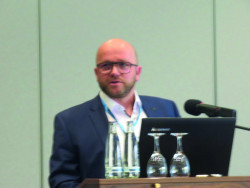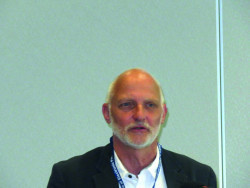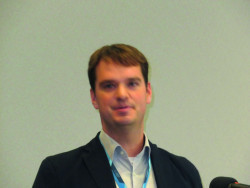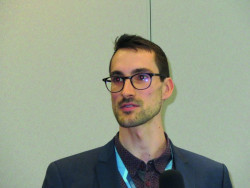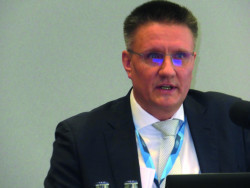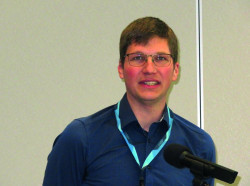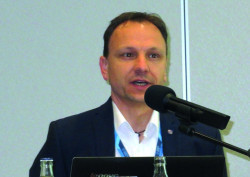AllMeSa hosted the Mechatronics 2022 Alliance Days at the Bilderberg Bellevue Hotel Dresden in mid-April. Technologies and products of the future of high-performance mechatronics were presented.
The AllMeSa Days 2022 of the Mechatronics Alliance Saxony offered 22 overview and specialist presentations, including 5 keynotes and tours of the partners Adenso, i2s, TU Dresden/IAVT and Xenon. Of the almost 100 participants, 59% came from industry and 41% from research.
The AllMeSa partners include Sitec Industrietechnologie, Chemnitz, Xenon Automatisierungstechnik, Adenso Industrial Services, i2s Intelligente Sensorsysteme Dresden, Kontron AIS, sunfire, all from Dresden, and Vitesco Technologies from Limbach-Oberfrohna. It also includes the Fraunhofer Institute for Material and Beam Technology IWS, Dresden, the Institute of Packaging and Interconnection Technology of the TU Dresden (IAVT) and ITW e.V. Chemnitz.
The vision of AllMeSa is to develop innovative technological solutions for the manufacture of mechatronic products of the future. The partners offer the core competencies required for this and jointly realize a technology platform that covers everything from prototype construction to series production of high-performance mechatronic products.
At the opening, Dr. Robin Schulze, Sitec Industrietechnologie, thanked the Federal Ministry of Education and Research (BMBF) for the funding as part of the 'Innovative Regional Growth Cores' program and the Saxon Working Group for Electronics Technology (SAET) for the cooperation.
Before Dr. Robin Schulze informed about the event program, Prof. Dr. Reinhard Bauer, HTW, Dresden, gave the greetings of the SAET. He thanked the AllMeSa partners for being able to participate in the AllMeSa Days 2022 as the 78th SAET meeting. This is because the SAET is a platform for the professional exchange of experience with 2 to 3 meetings a year at different locations in companies and research institutions.
The focus is on the areas of electronics design and technology, electronic device technology, manufacturing and process technology, systems engineering, quality assurance and reliability testing as well as component and assembly characterization.
Keynotes: Power transistors and PCB roadmap
Dr. Stefan Hain, ZF Friedrichshafen, explained in his presentation 'Silicon carbide as a driver of electromobility - how carbon increases the efficiency of electric cars' how a drive inverter works and described the properties of the power transistors (IGBT) commonly used in the field of e-mobility. Their efficiency is based on a compromise between conduction and switching losses. SiC MOSFETs are more advantageous here due to the material and SiC-based drive inverters have 64% fewer losses (0.3kWh compared to 0.84kWh per 100km), as studies have shown. The fast-charging capability and performance (higher temperatures) are also significantly better. However, SiC is more expensive than Si. The overall costs decide what is ultimately used. However, there is a clear trend towards SiC, which will dominate from 2030. As carbon increases efficiency, silicon carbide will become the driver of electromobility.
Ralph Fiehler, KSG, Gornsdorf, presented the roadmap for European PCB technology and the most important future trends based on the current situation and the most important technology drivers. The number of layers will continue to increase and the tolerances, inner layer and PCB thicknesses as well as the conductor pattern structures will be further reduced. Among other things, it is predicted that SBU/HDI structures with 12 layers (3+X+3) and L/S of 75µm and inner layer thicknesses of 100µm will also be realized in volume production by 2025. High-end production will be able to realize even more sophisticated structures up to L/S of 15 µm. In addition, the bore density and aspect ratio will be increased. Flex and rigid-flex as well as structures with impedance control, mixed structures, high-Tg, halogen-free and/or CAF-resistant base materials will also be increasingly used. Also with embedding or integration of functionalities. In the course of digitalization, additive manufacturing techniques are being introduced. The digital solder mask is already a reality.
AllMeSa projects and company management
In the following session, the AllMeSa projects were briefly presented:
- Benjamin Reichelt, Xenon Automatisierungstechnik GmbH, presented the project Novel manufacturing and testing technologies for MEMS pressure cell transducers.
- Dr. Karsten Sager, i2s Intelligente Sensorsysteme Dresden GmbH, provided information on the project "Novel pressure cell structuring using laser processing".
- Uwe Beier, Adenso Industrial Services GmbH, described the glass sensor technology project for the fuel cell/electrolysis stack.
In addition to the objectives and distribution of tasks, the current status and next steps of the respective projects were explained.
After a break, the participants went on to the company tours, which were offered again the following day. Visitors could choose to visit one of the organizations and see for themselves how the AllMeSa projects are implemented:
Adenso Industrial Services offers solutions for cleanroom automation, wafer handling and film and ultra-thin glass processing, among others. These include, for example, a roll-to-roll platform for flexible materials, on the basis of which the demonstrator system for glass sensor technology is being realized.
i2s Intelligente Sensorsysteme Dresden develops and produces specific pressure, temperature and combination sensors for several measured variables for customers. The company mainly works for customers in the automotive, mechanical engineering and measurement and testing technology sectors.
Xenon Automatisierungstechnik offers everything from assembly cells to complete lines for the production of automotive, electronics and medical technology applications. This is based on scalable, flexible modular automation platforms in combination with a smart software solution. This allows special machines and systems to be realized, such as for the production of pressure sensors in MEMS technology.
The TUD-IAVT is involved in a wide range of activities with various aspects of system integration. The institute works on both the process and process technology side, with the electronic assembly taking center stage. The numerous publicly funded research projects at the IAVT also include AllMeSa projects. The first day was rounded off with an evening event and intensive networking.
Keynotes on the second day - LIDE and sensor technology
Dr. Robin Schulze opened and moderated the second day, which began with three keynotes.
Dr. Christian Kelb, LPKF, presented 'New Possibilities for Glass in Microsystems Technology'. Due to its favorable properties, glass is ideal for packaging, but until now it has only presented challenges, i.e. it is difficult to process. Now, LPKF's LIDE (Laser Induced Deep Etching) technology, a two-stage process involving laser structuring and wet etching, offers a new solution for the precision micromachining of glass. It can be used to realize deep microstructures in glass without special glass, chipping and microcracks, e.g. TGV (Through Glass Vias) with diameters of 10µm to 100µm and large aspect ratios of up to 1:50. And soon a glass fusion bonding based on LIDE will also be available. LIDE production systems are already available from LPKF LIDE is also offered as a service via the subsidiary Vitrion.
Robert Bramberger from Liebherr then described the challenges on the way to a networked tower crane. He presented his company in advance and provided information about the different crane types and their special features. In the context of digitalization, networking is also the order of the day on construction sites. With LiDAT, there is already a Liebherr system for fleet management and maintenance management. Maintenance also includes checking the high-strength pre-stressed bolted connections on crane components.
A sensor system is currently being developed to monitor the bolt preload during crane operation and report any deviations. The challenges here are the magnitude of the preloads to be measured and the permanent and weather-independent integration of the measuring unit into components. The sensor is based on piezoceramics and communicates with radio signals. Technology tests are currently underway on a standardized test bench to determine force-displacement curves as well as tests for installation and display on a test crane. The next steps will be integration into the Liebherr environment and integration into construction site networks.
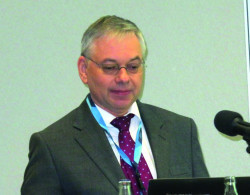 Dr. Andreas LenkDr. Andreas Lenk, Vitesco Technologies, listed SOEC, AEC and PEM cells as alternatives for electrolytic hydrogen production before highlighting the challenges in the development of production technologies for PEM electrolysis stacks. For electrolysis with PEM cells (proton exchange membrane/polymer electrolyte membrane), iridium dioxide is used as a catalyst, which is expensive. The polymer membrane of the electrolysis cell, which is made of the material Nafion, is coated with the catalyst. A demonstrator line for the decal process for the production of catalyst-coated membranes for PEM fuel cells is being developed as part of an HZwo funding project.
Dr. Andreas LenkDr. Andreas Lenk, Vitesco Technologies, listed SOEC, AEC and PEM cells as alternatives for electrolytic hydrogen production before highlighting the challenges in the development of production technologies for PEM electrolysis stacks. For electrolysis with PEM cells (proton exchange membrane/polymer electrolyte membrane), iridium dioxide is used as a catalyst, which is expensive. The polymer membrane of the electrolysis cell, which is made of the material Nafion, is coated with the catalyst. A demonstrator line for the decal process for the production of catalyst-coated membranes for PEM fuel cells is being developed as part of an HZwo funding project.
AllMeSa parallel sessions and company tours
After a break, there were three parallel sessions, each concluding with Q&A.
Session 1, moderated by Thomas Dreyer, on novel manufacturing and testing technologies for MEMS pressure cell transducers included the following contributions:
- Handling system for automated assembly of a sensor subassembly by Benjamin Reichelt, Xenon Automatisierungstechnik
- Production of functional layers by coating using cold plasma by Prof. Dr. Bernd Hommel, ITW e.V. Chemnitz
- Use of AI computer vision methods in the quality control of industrial computers by Thomas Dreyer, Kontron AIS
- Modification of metal powder to increase the reactivity of thermal joining pastes by Lukas Stepien, FhG-IWS
- MGA technology - Development of a glass solder-based joining technology for MEMS pressure sensor elements by Dr. Karsten Sager, i2s Intelligente Sensorsysteme Dresden.
Session 2 on novel print cell structuring using laser processing was moderated by Dr. Karsten Meier and included the following contributions:
- Laser instead of lithography - technology development for the production of pressure sensors by Philip Knoch, IAVT TU Dresden
- Pressure transmitter with laser-structured pressure measuring cell by Dr. Karsten Sager, i2s Intelligente Sensorsysteme Dresden
- Integration of the laser processing station into the system for manufacturing pressure measuring cells by Dominique Schubert, Sitec Industrietechnologie
- Process automation for the production of laser-structured stainless steel pressure measuring cells by Benjamin Reichelt, Xenon Automatisierungstechnik.
Session 3, moderated by Dr. Robin Schulze, was dedicated to glass sensor technology for the fuel cell or electrolysis stack and included the following contributions:
- Laser fabrication of ultra-thin glass in sheet or roll-to-roll processes by Dr. Schulze, Sitec Industrietechnologie,
- Roll-to-roll process for the production of flexible glass sensors for a wide temperature range by Uwe Beier, Adenso Industrial Services,
- Advantages of glass substrate sensors in Sunfire's electrolysis stacks by Dr. Ludwig Reichel, sunfire,
- Hybrid technology on ultra-thin glass as the key to high-temperature sensor technology by Philip Knoch, TU Dresden, Institute of Electronic Packaging Technology,
- Technology for the production of glass composites by reactive soldering by Prof. Dr. Bernd Hommel, ITW e.V. Chemnitz.
As on the previous day, company tours were offered after the lunch break - a fitting conclusion to a successful, practice-oriented event.


